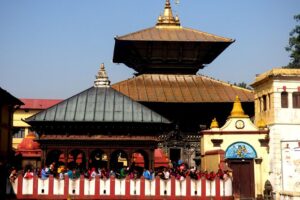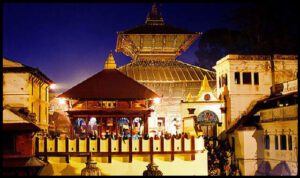Pashupatinath Temple lies on the banks of the Bagmati River, a beacon of faith and tradition that has stood the test of time in the bustling capital of Kathmandu This holy site is known as a spiritual haven, and not just a centerpiece of Nepal’s religious life ; It is a fabric woven with unwavering threads of culture, history and devotion that transcends the ages.
The essence of commitment
Imagine a place where the air carries age-old mantras, and the cobbled streets are filled with colorful humanity, anyone seeking solace or understanding that Pashupatinath Temple is such a place. It commands respect from all walks of life as the worshiped abode of Lord Shiva, the national deity. Here the spiritual dances with the divine, inviting all who wander in the surroundings to seize the moment and contemplate the divine aspects of life.
Pashupatinath Temple Bodh
Located on the banks of the Bagmati River in Kathmandu, Nepal, Pashupatinath Temple is more than just another temple; It is a symbol of faith, spirituality and architecture. This book delves into the significance of this temple in Hinduism, its status as a UNESCO World Heritage Site, and the unique architecture and vibrant festivals celebrated here.
A. The Spiritual Significance
Pashupatinath Temple holds a paramount place in Hinduism. It is dedicated to Lord Shiva, one of the major deities in Hindu culture, revered as the protector and transformer within the Trimurti, the Hindu Triad that includes Brahma and Vishnu. The temple serves as a site for asceticism, meditation, and worship, attracting thousands of pilgrims and ascetics from across the globe, especially from India and Nepal. Its recognition as a UNESCO World Heritage Site in 1979 further emphasizes its global significance, not just spiritually but also culturally and historically. This distinction marks it as an invaluable piece of human history and spirituality, preserved for future generations to experience and understand.
B. Architectural Splendor
The architecture of Pashupatinath Temple is a sight to behold. A blend of Nepalese roof-tiered structures, cubic constructions, and intricately carved wooden rafters, it showcases the excellence of traditional Nepali craftsmanship. Built in the pagoda style of architecture, the main temple houses a sacred lingam, or phallic symbol of Lord Shiva, and boasts a silver-plated door surrounded by images of various deities. The complex is sprawling, encompassing numerous other temples and ashrams, each displaying a facet of Nepalese temple architecture and offering a peaceful sanctuary for meditation and worship.
C. The Temple’s Festivals
Several festivals breathe life into Pashupatinath throughout the year, drawing devotees in large numbers. Some of the major festivals include:
- Maha Shivaratri: This is the Great Night of Shiva, celebrated with great fervor. Hundreds of thousands of pilgrims visit every year to offer prayers, observe a day-long fast, and participate in the all-night vigil.
- Teej: Dedicated predominantly to the women of Nepal, this festival signifies marital happiness and well-being. Women clad in red sarees visit the temple, perform rituals, and sing and dance to traditional songs.
- Bala Chaturdashi: In remembrance of the deceased, families scatter sesame seeds and offer prayers throughout the temple complex.
Weather and seasons in Kathmandu
Exploring the Pashupatinath Temple, the spiritual heart of Nepal, is a very different experience from the highs and lows of Kathmandu. Your visit can be greatly enhanced by understanding the weather and seasonal changes in Kathmandu, allowing you to connect more closely with the cultural and religious life that is intimately associated with the ancient stones of the temple.
A. Overview of Kathmandu’s Climate
Kathmandu’s climate is primarily tempered by its location in the Kathmandu Valley and its altitude. The city experiences four distinct seasons:
- Spring (March to May): This season sees warm days with cool mornings and evenings. Temperatures typically range from 10°C in the mornings to 28°C during the day. This is a beautiful time of year, with flowers blossoming across the city and the valley.
- Monsoon/Summer (June to August): The monsoon season brings heavy rainfalls, rejuvenating the valley with lush greenery. Temperatures are warm, between 20°C and 30°C, but the humidity can make it feel warmer.
- Autumn (September to November): Characterized by clear skies and mild weather, autumn sees temperatures ranging from 10°C to 25°C. It is considered one of the best times to visit Kathmandu for its festivals and clear mountain views.
- Winter (December to February): Winters are cold, especially in the mornings and evenings, with temperatures sometimes dropping below 0°C at night. Daytime temperatures can rise to about 20°C, making it a chilly but often sunny time to explore.
B. How Weather Affects Your Visit
The changing climate of Kathmandu can dramatically affect your experience at Pashupatinath Temple:
- Spring: The temple comes alive with color and vitality. The temperate climate makes exploring the extensive temple grounds pleasant. Spring is also a significant time for Hindu festivals, making it an ideal season to witness the cultural vibrancy of Pashupatinath.
- Monsoon/Summer: Visiting during the monsoon can be challenging due to heavy rainfall, which might limit your movement and outdoor rituals. However, the temple in the rain has a unique, serene ambiance; just be prepared with waterproof gear.
- Autumn: With clear weather and moderate temperatures, autumn provides the perfect backdrop for visiting Pashupatinath Temple. The festival of Dashain, usually in October, sees the temple and its devotees in a flurry of religious activity.
- Winter: The cold can be biting, especially early in the morning or late in the evening during aarti ceremonies. Yet, the quieter nature of the temple during winter can offer a more meditative and reflective visit.
Best Times to Visit
Visiting the sacred Pashupatinath Temple in Kathmandu offers a rich tapestry of cultural and spiritual experiences. The timing of your visit can significantly influence your experience, from navigating through crowds to enjoying pleasant weather. Understanding the peak seasons, weather patterns, and budget-friendly times can help you plan an enriching visit to this historic sanctuary.
A. Peak Tourist Seasons
Kathmandu’s Pashupatinath Temple sees fluctuations in tourist traffic throughout the year, which can impact both your temple visit and accommodation arrangements.
- High Season (September to November): Autumn brings clear skies and moderate temperatures, making it ideal for visiting Pashupatinath Temple. However, this is also when tourist traffic is at its peak, making temple grounds more crowded and accommodation rates higher.
- Low Season (June to August): The monsoon season sees fewer tourists due to heavy rainfall. While temple access can be more challenging due to wet conditions, you’ll find fewer crowds and more competitive prices for accommodation.
B. Optimal Months for Weather
Weather plays a crucial role in planning your visit. Here’s a breakdown:
- January to February: Cold with daytime temperatures around 10°C. Clear days may offer a peaceful visit, albeit chilly.
- March to May: Warm weather with temperatures up to 30°C. Spring is vibrant, making it a pleasant time for temple visits.
- June to August: Monsoon season brings heavy rain, causing potential disruption but offers a unique, lush experience of the temple surroundings.
- September to November: Post-monsoon, the weather is cool and clear, ideal for exploration.
- December: Begins to get colder, but the early part of the month is still manageable for visits.
C. Recommendations for Budget Travelers
Budget-conscious travelers can maximize their experience with strategic timing:
- Consider Early December or Late February: These periods border the colder winter months but escape the peak season’s high prices. You’ll find fewer crowds and better deals on accommodation.
- Monsoon Season (June to August): If you don’t mind the rain, this season offers the lowest prices on accommodation and fewer tourists. It’s ideal for those looking to explore Pashupatinath Temple in solitude and save money.
Festival Calendar and Events
A visit to Pashupatinath Temple in Kathmandu can become even more memorable if complimented by the vibrant festivals and events that occur throughout the year. The communion of devotees, special rituals, and mesmerizing cultural traditions add a unique charm to the temple experience.
A. Maha Shivaratri
Maha Shivaratri holds a place of prime significance in the annual calendar of Pashupatinath Temple. Celebrated usually in February or March (on the 14th day of the dark fortnight of the Hindu month Phalgun), this festival honors Lord Shiva, to whom the temple is dedicated.
During Maha Shivaratri, the temple turns into a hive of activity. Hundreds of thousands of devotees, including a large number of Sadhus (holy men), gather at the temple from across India and Nepal. Visitors can expect to witness rituals performed throughout the night, ceremonial fires, meditative chants, and processions – all creating an intense spiritual atmosphere.
B. Teej and Other Festivals
Teej, typically in August or September, is another significant festival celebrated mainly by Hindu women in Nepal. Women adorn themselves in red sarees and gold jewelry, fast for marital bliss, and participate in dances and songs. The crowd of colorfully dressed women at Pashupatinath Temple during Teej is a beautiful spectacle.
Other notable festivals include:
- Janai Purnima (August): Known as the Sacred Thread Festival, it sees thousands of Hindus and Buddhists come to the temple to perform rituals and change their Janai (sacred thread).
- Bala Chaturdashi (November or December): Devotees scatter seeds in memory of their departed loved ones, turning the temple grounds into a sea of glowing lights.
C. Special Puja Events
Special pujas (prayer rituals) and astrologically significant events are common occurrences at the temple. For example:
- Saturn’s Day Puja: Conducted every Saturday as Saturn is a disciple of Lord Shiva. Devotees undertake this puja to eliminate negative effects in their astrological charts.
- Purnima (Full Moon Day) Puja: On every full moon day, special rites are performed in honor of Lord Shiva, attracting many devotees.
The temple management frequently organizes other special pujas on various astrologically auspicious dates. Visitors intending to participate or witness such special pujas can check the temple’s official calendar.
Festival Calendar and Events at Pashupatinath Temple
The Pashupatinath Temple in Kathmandu is not only a marvel of architecture but also a hub for a multitude of festivals and events throughout the year. Each festival paints the temple in new colors of traditions and rituals, attracting devotees and tourists alike.
A. Maha Shivaratri
Maha Shivaratri is the pinnacle of festivals celebrated at Pashupatinath Temple. It’s a festival in devotion to Lord Shiva, occurring annually around February or March.
- Significance: It marks the day Lord Shiva is believed to have saved the world from darkness and ignorance.
- Date: Follows the lunar calendar, generally on the 14th day of the waning moon in the month of Phalgun.
- Visitor Experience:
- Witness all-night worship and the chant of ‘Om Namah Shivaya.’
- See an influx of Sadhus, some covered in ashes.
- Observe thousands of lamps lighting up the temple.
B. Teej and Other Festivals
Apart from Maha Shivaratri, there are multiple festivals throughout the year that highlight the cultural richness of Pashupatinath.
- Teej:
- Celebrated predominantly by women for marital bliss.
- The temple is adorned with red as women dress in vibrant sarees.
- Fasting, singing, and dancing events take place.
- Other Key Festivals:
- Janai Purnima: It’s a day when Hindus renew their commitment to the faith.
- Bala Chaturdashi: Families remember lost loved ones with lamps and prayers.
C. Special Puja Events
The temple calendar is filled with specific pujas and days of astrological significance.
- Regular Pujas:
- On Saturdays for Saturn, a devotee of Lord Shiva.
- Full moon days draw crowds for special ceremonies.
- Astrological Events:
- Eclipse days often feature unique rituals.
- Special arrangements for days like ‘Harishayani Ekadashi.’
conclusion
The best time to visit Pashupatinath Temple depends on a mixture of factors:
- Climate: September to November brings clear skies and pleasant temperatures.
- Festivals: Plan around events like Mahashivratri to experience the temple during the festival.
- Personal preference: Whether you want peaceful contemplation or a warm celebration, tailor your visit accordingly.
Remember, visiting Pashupatinath Temple is more than just booking a place on your list. It’s a chance to experience the living traditions and spirituality that has shaped Kathmandu for generations.
Final Thoughts
If you are planning to visit Pashupatinath Temple, keep in mind that it is a holy place for many people. Respect the site, immerse yourself in the local culture and take the peace of mind with you. With proper preparation, your visit can be an experience that resonates long after your home.



